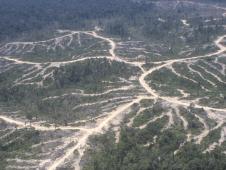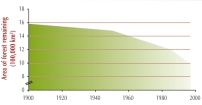
By 2000, Indonesia had lost 40% of its forest cover, and the rate of deforestation is accelerating. Indonesia’s production capacity for wood-pulp and paper has grown by 700% since the late 1980s, and is at a level that cannot be met by any form of sustainable forest management.

Indonesia was still densely forested as recently as 1950, but between then and 2000 c.40% of the country’s forests was cleared (FWI/GFW 2002), and this rate of loss is accelerating (see figure). Approximately 10,000 km2 of forest were cleared annually in the 1980s, rising to c.17,000 km2 per year in the early 1990s. Since 1996, deforestation has increased to an average rate of 20,000 km2 per year. These losses are concentrated on non-swamp lowland forest, the type richest in biodiversity. Between 1985 and 1997, Sumatra lost 29% of its forests, and Kalimantan 22% (Holmes 2000). Unless the rate of deforestation is reduced or halted, non-swamp lowland forest in Sumatra will disappear by 2005, and in Kalimantan by 2010 (Holmes 2000). Indonesia’s forests are being felled for timber and wood-pulp (c.40 million cubic metres per year; FWI/GFW 2002), and the land is then converted to other uses such as oil palm plantations. Indonesia’s production capacity for wood-pulp and paper has grown by 700% since the late 1980s, and is at a level that cannot be met by any form of sustainable forest management (Bryant et al. 1997). This growth has been achieved mainly through illegal logging and land clearance. Around 73% of log production in Indonesia is illegal and occurs outside designated forestry concessions (Holmes 2000).
Related Case Studies in other sections
References
Compiled: 2004
Recommended Citation:
BirdLife International (2004)
Lowland forests will have been destroyed across large parts of Indonesia by 2010.
Downloaded from https://datazone.birdlife.org/sowb/casestudy/lowland-forests-will-have-been-destroyed-across-large-parts-of-indonesia-by-2010 on 12/01/2025